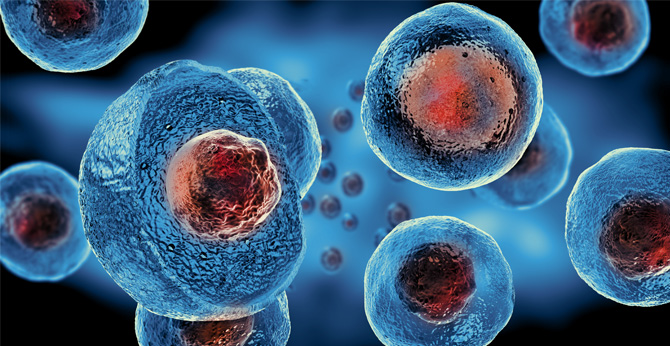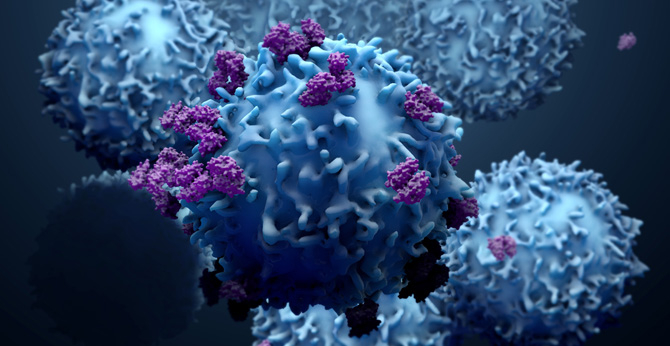All products and services are For Research Use Only and CANNOT be used in the treatment or diagnosis of disease.
The protein encoded by the classic MBP gene is a major constituent of the myelin sheath of oligodendrocytes and Schwann cells in the nervous system. However, MBP-related transcripts are also present in the bone marrow and the immune system. These mRNAs arise from the long MBP gene (otherwise called "Golli-MBP") that contains 3 additional exons located upstream of the classic MBP exons. Alternative splicing from the Golli and the MBP transcription start sites gives rise to 2 sets of MBP-related transcripts and gene products. The Golli mRNAs contain 3 exons unique to Golli-MBP, spliced in-frame to 1 or more MBP exons. They encode hybrid proteins that have N-terminal Golli aa sequence linked to MBP aa sequence. The second family of transcripts contain only MBP exons and produce the well characterized myelin basic proteins. This complex gene structure is conserved among species suggesting that the MBP transcription unit is an integral part of the Golli transcription unit and that this arrangement is important for the function and/or regulation of these genes.
 Loading...
Loading...
| CAT | Product Name | Target Species | Antibody Clone | Antibody Host | Receptor Construction | Vector Type | Targeting Cell Type | CAR Vector Type | Inquiry & Datasheet |
| CAR-M0628-YC | Anti-MBP (2H9) h(scFv-CD28-CD3ζ) CAR, pCDCAR1 | Human | 2H9 | Mouse | scFv-CD28-CD3ζ | Lentiviral vector | T cell | ||
| CAR-MV-01LX232 | Anti-MBP (A10) h(CD28-CD3ζ) CAR, pMMLV | Human | A10 | Human | scFv-CD28-CD3ζ | Recombinant Moloney murine leukemia virus (MMLV) retroviral vector | T cell | ||
| CAR-MV-01LX233 | Anti-MBP (B5) h(CD28-CD3ζ) CAR, pMMLV | Human | B5 | Human | scFv-CD28-CD3ζ | Recombinant Moloney murine leukemia virus (MMLV) retroviral vector | T cell | ||
| CAR-MV-01LX234 | Anti-MBP (B5V6) h(CD28-CD3ζ) CAR, pMMLV | Human | B5V6 | Human | scFv-CD28-CD3ζ | Recombinant Moloney murine leukemia virus (MMLV) retroviral vector | T cell | ||
| CAR-MV-01LX235 | Anti-MBP (D1) h(CD28-CD3ζ) CAR, pMMLV | Human | D1 | Human | scFv-CD28-CD3ζ | Recombinant Moloney murine leukemia virus (MMLV) retroviral vector | T cell | ||
| CAR-MV-01LX236 | Anti-MBP (D12) h(CD28-CD3ζ) CAR, pMMLV | Human | D12 | Human | scFv-CD28-CD3ζ | Recombinant Moloney murine leukemia virus (MMLV) retroviral vector | T cell | ||
| CAR-MV-01LX237 | Anti-MBP (E2) h(CD28-CD3ζ) CAR, pMMLV | Human | E2 | Human | scFv-CD28-CD3ζ | Recombinant Moloney murine leukemia virus (MMLV) retroviral vector | T cell | ||
| CAR-MV-01LX238 | Anti-MBP (E6) h(CD28-CD3ζ) CAR, pMMLV | Human | E6 | Human | scFv-CD28-CD3ζ | Recombinant Moloney murine leukemia virus (MMLV) retroviral vector | T cell | ||
| CAR-MV-01LX239 | Anti-MBP (F11) h(CD28-CD3ζ) CAR, pMMLV | Human | F11 | Human | scFv-CD28-CD3ζ | Recombinant Moloney murine leukemia virus (MMLV) retroviral vector | T cell | ||
| CAR-MV-01LX240 | Anti-MBP (NT12a) h(CD28-CD3ζ) CAR, pMMLV | Human | NT12a | Human | scFv-CD28-CD3ζ | Recombinant Moloney murine leukemia virus (MMLV) retroviral vector | T cell | ||
| CAR-MV-01LX241 | Anti-MBP (NT18) h(CD28-CD3ζ) CAR, pMMLV | Human | NT18 | Human | scFv-CD28-CD3ζ | Recombinant Moloney murine leukemia virus (MMLV) retroviral vector | T cell | ||
| CAR-MV-01LX242 | Anti-MBP (NT5) h(CD28-CD3ζ) CAR, pMMLV | Human | NT5 | Human | scFv-CD28-CD3ζ | Recombinant Moloney murine leukemia virus (MMLV) retroviral vector | T cell | ||
| CAR-MV-01LX243 | Anti-MBP (NT5.1) h(CD28-CD3ζ) CAR, pMMLV | Human | NT5.1 | Human | scFv-CD28-CD3ζ | Recombinant Moloney murine leukemia virus (MMLV) retroviral vector | T cell | ||
| CAR-MV-01LX244 | Anti-MBP (NT56) h(CD28-CD3ζ) CAR, pMMLV | Human | NT56 | Human | scFv-CD28-CD3ζ | Recombinant Moloney murine leukemia virus (MMLV) retroviral vector | T cell | ||
| CAR-MV-01LX477 | Anti-MBP (A10) h(41BB-CD3ζ) CAR, pMMLV | Human | A10 | Human | scFv-41BB-CD3ζ | Recombinant Moloney murine leukemia virus (MMLV) retroviral vector | T cell | ||
| CAR-MV-01LX478 | Anti-MBP (B5) h(41BB-CD3ζ) CAR, pMMLV | Human | B5 | Human | scFv-41BB-CD3ζ | Recombinant Moloney murine leukemia virus (MMLV) retroviral vector | T cell | ||
| CAR-MV-01LX479 | Anti-MBP (B5V6) h(41BB-CD3ζ) CAR, pMMLV | Human | B5V6 | Human | scFv-41BB-CD3ζ | Recombinant Moloney murine leukemia virus (MMLV) retroviral vector | T cell | ||
| CAR-MV-01LX480 | Anti-MBP (D1) h(41BB-CD3ζ) CAR, pMMLV | Human | D1 | Human | scFv-41BB-CD3ζ | Recombinant Moloney murine leukemia virus (MMLV) retroviral vector | T cell | ||
| CAR-MV-01LX481 | Anti-MBP (D12) h(41BB-CD3ζ) CAR, pMMLV | Human | D12 | Human | scFv-41BB-CD3ζ | Recombinant Moloney murine leukemia virus (MMLV) retroviral vector | T cell | ||
| CAR-MV-01LX482 | Anti-MBP (E2) h(41BB-CD3ζ) CAR, pMMLV | Human | E2 | Human | scFv-41BB-CD3ζ | Recombinant Moloney murine leukemia virus (MMLV) retroviral vector | T cell | ||
| XS-0823-LX77 | Anti-hMBP (A10) ICD(CD28-OX40-CD3ζ) CAR-MA, pAd5f35 Vector | Human | A10 | Adenoviral vectors |
 NEWSLETTER
NEWSLETTER
The latest newsletter to introduce the latest breaking information, our site updates, field and other scientific news, important events, and insights from industry leaders
LEARN MORE NEWSLETTER NEW SOLUTION
NEW SOLUTION
CellRapeutics™ In Vivo Cell Engineering: One-stop in vivo T/B/NK cell and macrophage engineering services covering vectors construction to function verification.
LEARN MORE SOLUTION NOVEL TECHNOLOGY
NOVEL TECHNOLOGY
Silence™ CAR-T Cell: A novel platform to enhance CAR-T cell immunotherapy by combining RNAi technology to suppress genes that may impede CAR functionality.
LEARN MORE NOVEL TECHNOLOGY NEW SOLUTION
NEW SOLUTION
Canine CAR-T Therapy Development: From early target discovery, CAR design and construction, cell culture, and transfection, to in vitro and in vivo function validation.
LEARN MORE SOLUTION

